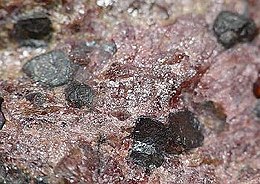| Manganosite | |
|---|---|
 | |
| General | |
| Category | Oxide mineral |
| Formula (repeating unit) | Manganese oxide, MnO |
| IMA symbol | Mng[1] |
| Strunz classification | 4.AB.25 |
| Crystal system | Cubic |
| Crystal class | Hexoctahedral (m3m) H-M symbol: (4/m 3 2/m) |
| Space group | Fm3m |
| Unit cell | a = 4.44 Å; Z = 4 |
| Identification | |
| Color | Emerald-green, becoming black on exposure to air |
| Crystal habit | Granular to massive; Octahedral crystals uncommon |
| Cleavage | Perfect on [100], [010] and [001] |
| Fracture | Fibrous |
| Mohs scale hardness | 5–6 |
| Luster | Vitreous, adamantine to dull |
| Streak | Brown |
| Diaphaneity | Transparent to translucent |
| Specific gravity | 5.364 |
| Optical properties | Isotropic |
| Refractive index | n = 2.16–2.17 |
| References | [2][3][4][5] |
Manganosite is a rare mineral composed of manganese(II) oxide MnO. It was first described in 1817 for an occurrence in the Harz Mountains, Saxony-Anhalt, Germany.[4] It has also been reported from Langban and Nordmark, Sweden and at Franklin Furnace, New Jersey. It also occurs in Japan, Kyrgyzstan and Burkina Faso.[5]
It occurs in manganese nodules. It also occurs as alteration of manganese minerals such as rhodocrosite during low oxygen metamorphism and metasomatism.[5]
References
[edit]- ^ Warr, L.N. (2021). "IMA–CNMNC approved mineral symbols". Mineralogical Magazine. 85 (3): 291–320. Bibcode:2021MinM...85..291W. doi:10.1180/mgm.2021.43. S2CID 235729616.
- ^ Mineralienatlas
- ^ Manganosite data on Webmineral
- ^ a b Manganosite data from Mindat.org
- ^ a b c Manganosite in the Handbook of Mineralogy